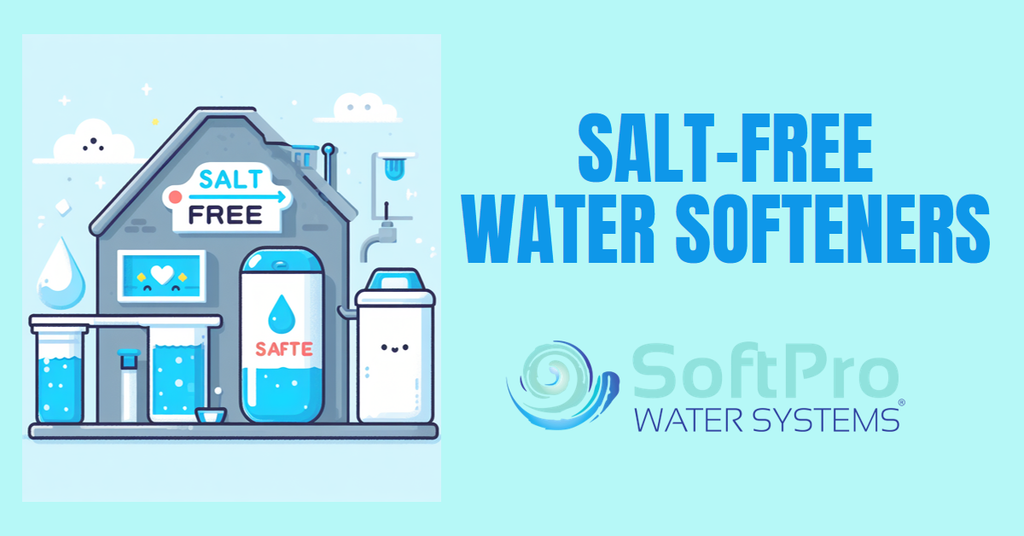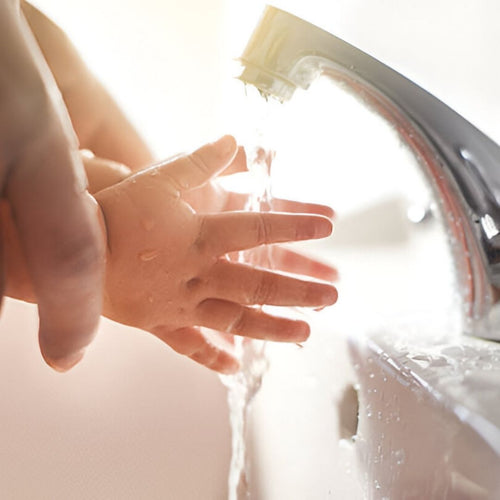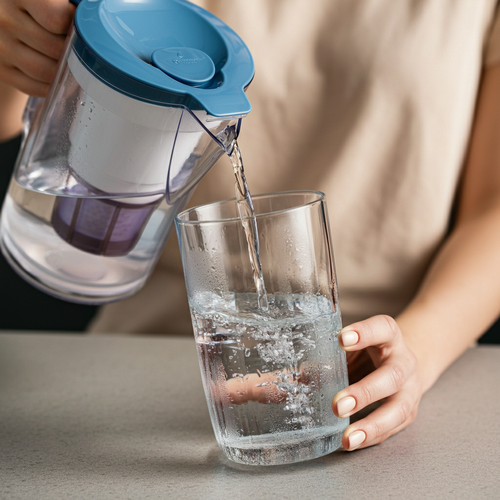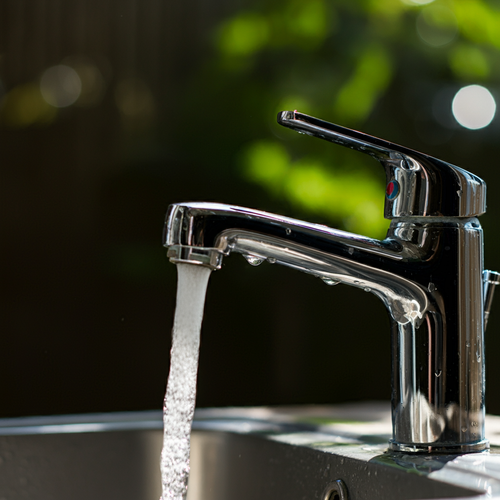What are Salt-free Water Softeners?
Salt-free water softeners, also known as saltless water conditioners, are alternative solutions to traditional salt-based systems for addressing hard water problems. Unlike their traditional counterparts, they don't utilize salt (sodium chloride) to remove hardness minerals like calcium and magnesium. Instead, they employ various technologies to alter the physical or chemical properties of these minerals, preventing them from clinging to surfaces and forming the dreaded scale buildup.
Types of Salt-free Technology:
- Template-assisted crystallization (TAC): This technology features media beds containing specially designed templates that attract and "trap" hardness minerals, causing them to crystallize in a harmless, microscopic form. The crystals get flushed out during the system's regeneration cycle.
- Electromagnetic: These systems use magnetic fields to alter the charge of hardness minerals, making them repel each other and preventing them from sticking to surfaces. However, their effectiveness can vary depending on the water hardness level.
- Chelation: Chelating agents bind with hardness minerals, forming soluble complexes that get carried away with the water flow. While effective for moderate hardness, this technology might require more frequent maintenance than others.
Benefits of Choosing Salt-free:
- Environmentally friendly: No salt discharge eliminates concerns about brine pollution and environmental impact.
- Lower maintenance: No salt refills or brine disposal tasks compared to traditional softeners.
- Potentially gentler on skin and hair: Reduced scale buildup can lead to softer, smoother skin and hair.
- No salty taste or odor: Unlike salt-based systems, salt-free options don't affect the taste or smell of your water.
Limitations to Consider:
- Effectiveness: While effective for moderately hard water, salt-free systems might not be as efficient in areas with exceptionally hard water.
- Maintenance: Some technologies, like chelation, may require more frequent cleaning or media replacement compared to others.
- Initial cost: The upfront cost of salt-free systems can be higher than traditional softeners, though long-term cost savings through reduced maintenance can compensate.
Salt-free water softeners offer a promising alternative for those seeking an environmentally friendly and potentially lower-maintenance solution to hard water problems. However, it's crucial to understand their limitations and choose the most suitable technology based on your specific water hardness level and needs.
Understanding Hard Water and its Challenges
Let's delve deeper into the very reason why you might consider a salt-free water softener: hard water itself!
What is Hard Water?
Hard water is simply water with elevated levels of dissolved minerals, primarily calcium and magnesium. These minerals, while not harmful to health, can wreak havoc on your home, appliances, and even your comfort. The severity of the issue depends on the degree of hardness, measured in grains per gallon (gpg). In the US, the Water Quality Association (WQA) classifies hardness levels as follows:
- Soft: Less than 1 gpg
- Slightly hard: 1-3 gpg
- Moderately hard: 3-6 gpg
- Hard: 6-10 gpg
- Very hard: 10-15 gpg
- Extremely hard: Above 15 gpg
Challenges Posed by Hard Water:
The presence of these minerals manifests in various ways, leading to several inconveniences and potential damage:
- Scale buildup: The most visible consequence, hard water minerals leave behind unsightly and sometimes stubborn deposits on faucets, sinks, showerheads, and inside appliances like dishwashers and washing machines.
- Reduced appliance efficiency: Scale buildup within appliances can hinder their performance, shortening their lifespan and increasing energy consumption. Studies by the WQA estimate that hard water can decrease water heater efficiency by up to 22%, leading to higher energy bills.
- Skin and hair issues: Hard water can leave skin feeling dry and itchy, and hair dull and difficult to manage. This is due to the minerals interfering with soap and shampoo, preventing them from lathering effectively.
- Clogged pipes and fixtures: Over time, mineral buildup can narrow down pipe diameters, restricting water flow and potentially leading to clogs and plumbing issues.
Impact on Daily Life:
Hard water impacts more than just aesthetics. A 2012 study by the National Bureau of Economic Research found that homes with hard water spend 5-8% more on water heating and 18-25% more on laundry detergent compared to those with soft water. These hidden costs add up over time, making hard water treatment a worthwhile consideration.
How Do Salt-free Water Softeners Work?
Now that we've established the challenges posed by hard water, let's explore how salt-free water softeners tackle these minerals without relying on the traditional salt exchange method.
Remember, salt-free systems don't actually remove the hardness minerals. Instead, they modify them through various physical or chemical processes, preventing them from causing trouble in your home.
Here's a closer look at the different technologies:
1. Template-Assisted Crystallization (TAC):
- Mechanism: TAC systems utilize specially designed media beds containing templates that attract and "trap" hardness minerals like calcium and magnesium. These templates encourage the minerals to crystallize in a harmless, microscopic form, preventing them from sticking to surfaces and forming scale.
- Effectiveness: TAC systems work best for moderately hard water (up to 6 gpg) and are highly efficient at reducing scale buildup. However, their effectiveness may decrease in areas with extremely hard water.
- Maintenance: TAC systems typically require minimal maintenance, with regeneration cycles occurring automatically at set intervals.
2. Electromagnetic:
- Mechanism: These systems use magnetic fields to alter the charge of hardness minerals. This altered charge makes the minerals repel each other, preventing them from clinging to surfaces and forming scale.
- Effectiveness: The effectiveness of electromagnetic systems varies depending on water hardness levels. They may work well for slightly to moderately hard water but might not be as effective for harder water conditions.
- Maintenance: Electromagnetic systems typically require minimal maintenance, with no need for regeneration cycles or media replacements.
3. Chelation:
- Mechanism: Chelating agents bind with hardness minerals, forming soluble complexes that get carried away with the water flow. This effectively removes the minerals from the water.
- Effectiveness: Chelation is effective for moderately hard water but might not be suitable for extremely hard water due to the increased need for chelating agent replenishment.
- Maintenance: Chelation systems require more frequent maintenance compared to other salt-free technologies, as the chelating agent needs to be replaced regularly.
Choosing the Right Technology:
The best salt-free technology for your home depends on several factors, including your water hardness level, budget, and maintenance preferences. Consider consulting a water treatment professional to determine the ideal solution for your specific needs.
Benefits of Opting for Salt-free Water Softening
Now that we've explored how salt-free water softeners work, let's dive into the potential advantages of choosing this approach compared to traditional salt-based systems.
Environmental Friendliness:
- No salt discharge: Unlike traditional softeners that generate brine during regeneration, salt-free systems don't require salt, eliminating concerns about brine pollution and environmental impact. This aligns with growing environmental consciousness and sustainability efforts.
- Reduced water waste: Salt-free systems typically regenerate less frequently compared to salt-based softeners, leading to potential water savings. Research by the WQA suggests salt-free systems can use up to 50% less water than traditional softeners during regeneration.
Lower Maintenance:
- No salt refills or brine disposal: Salt-free systems eliminate the need for regular salt refills and the hassle of disposing of brine, which can be inconvenient and messy. This translates to less time and effort spent on maintenance.
- Simplified operation: Most salt-free systems operate automatically and require minimal user intervention, unlike salt-based softeners that might require setting regeneration cycles or monitoring salt levels.
Potential Health Benefits:
- Gentler on skin and hair: Hard water can leave skin feeling dry and itchy, and hair dull and difficult to manage. Salt-free systems, by reducing scale buildup and altering the mineral composition of water, can potentially alleviate these issues and leave skin feeling softer and hair more manageable.
- No added sodium: Traditional softeners add sodium to the water during regeneration, which can be a concern for individuals on sodium-restricted diets. Salt-free systems avoid this issue, maintaining the original sodium content of your water.
Other Advantages:
- No salty taste or odor: Unlike salt-based systems, salt-free solutions don't affect the taste or smell of your drinking water.
- Potential cost savings: While the initial cost of salt-free systems might be higher than traditional softeners, long-term savings on salt refills, brine disposal, and potentially water usage can offset the initial investment.
Drawbacks and Limitations of Salt-free Softening
While salt-free water softeners offer enticing benefits, it's essential to consider their limitations and potential drawbacks before making a decision.
Effectiveness Considerations:
- Hard water threshold: Salt-free systems, particularly electromagnetic and chelation technologies, might not be as effective in areas with extremely hard water (above 10 gpg). Traditional salt-based systems remain the more efficient solution for such situations.
- Varying performance: The effectiveness of certain technologies, like electromagnetic, can vary depending on the specific mineral composition of the water. Consulting a water treatment professional for a water analysis can help determine the most suitable technology.
- Maintenance needs: While generally lower than salt-based systems, some salt-free technologies like chelation require more frequent media replacements or cleaning compared to others, adding to maintenance costs.
Cost Comparisons:
- Initial investment: The upfront cost of salt-free water softeners can be higher than traditional salt-based systems, although the long-term cost savings through reduced maintenance and potentially lower water usage can compensate over time.
- Maintenance costs: While minimal for technologies like TAC, chelation systems require regular media replacements, adding to ongoing maintenance costs.
Other Considerations:
- Flow rate: Some salt-free systems, particularly TAC, can slightly reduce water flow compared to traditional softeners. This is typically not noticeable in everyday use but might be a concern for households with high water flow demands.
- Regeneration cycles: Certain salt-free technologies require more frequent regeneration cycles compared to salt-based systems, potentially impacting water and electricity usage.
Choosing wisely:
Understanding the limitations and potential drawbacks of salt-free water softeners allows you to make an informed decision based on your specific needs, water hardness level, and budget. Weighing the pros and cons and seeking professional advice if needed will ensure you choose the most suitable solution for tackling your hard water challenges.
Choosing the Right Salt-free Water Softener for Your Needs
Now that we've weighed the benefits and drawbacks of salt-free water softeners, let's navigate the selection process to find the perfect fit for your home.
Key Factors to Consider:
- Water hardness level: This critical factor determines the technology's effectiveness. As mentioned earlier, TAC excels for moderate hardness (up to 6 gpg), while electromagnetic and chelation might struggle with harder water (>10 gpg). For extreme hardness, traditional salt-based systems might be the better option.
- Household size and water consumption: Choose a system with adequate capacity to handle your household's water demand. Consider the number of occupants, water usage habits, and the presence of appliances with high water requirements like dishwashers and washing machines.
- Budget: Salt-free systems have varying upfront costs, with TAC generally falling on the higher end while chelation might be more budget-friendly. Factor in long-term maintenance costs associated with media replacements or cleaning for certain technologies.
- Maintenance preferences: Consider how much time and effort you're willing to invest in maintenance. While most salt-free systems require minimal intervention, chelation might require more frequent media replacements.
- Special needs: If you have specific concerns like skin or hair sensitivity, opting for a technology that minimizes scale buildup and potential mineral residue, like TAC, might be beneficial.
Additional Tips:
- Professional guidance: Consult a water treatment professional for a water analysis and personalized recommendations based on your specific needs and water conditions.
- Compare brands and models: Research different brands and models within your chosen technology, comparing features, capacities, warranties, and user reviews.
- Installation options: Decide if you prefer DIY installation or professional guidance. Most systems offer clear instructions for self-installation, but complex systems or specific plumbing configurations might require professional assistance.
Remember: There's no "one-size-fits-all" solution. By carefully considering these factors and researching your options, you can choose the salt-free water softener that effectively addresses your hard water challenges and suits your unique needs and preferences.
Maintaining Your Salt-free Water Softener for Optimal Performance
Once you've chosen the perfect salt-free water softener for your home, proper maintenance ensures it operates efficiently and delivers long-lasting benefits. Here's a guide to keeping your system in top shape:
General Maintenance:
- Regular cleaning: Most salt-free systems require periodic cleaning of the media bed to remove accumulated sediment and maintain optimal performance. Consult your system's manual for specific cleaning instructions and frequency recommendations. This typically involves backwashing the system to flush out any buildup.
- Filter replacements: Some systems, particularly those with pre-filters, might require occasional filter replacements. Refer to your manual for the recommended replacement schedule and ensure you use the correct filter type for your system.
- Monitor performance: Keep an eye on water flow and pressure. Reduced flow or pressure could indicate a need for cleaning or media replacement.
Technology-Specific Maintenance:
- Template-Assisted Crystallization (TAC): TAC systems require minimal maintenance, with regeneration cycles occurring automatically. However, monitor water flow and pressure as mentioned above, and consult the manual for specific cleaning instructions if needed.
- Electromagnetic: These systems require minimal maintenance and no media replacements. However, ensure the unit is properly connected to a power source and monitor water flow and pressure for potential issues.
- Chelation: Chelation systems typically require more frequent maintenance compared to other salt-free technologies. Replace the chelating media according to the manufacturer's recommendations, usually every 3-6 months depending on water hardness and usage.
Additional Tips:
- Water softener bypass: Most systems have a bypass valve allowing you to temporarily bypass the softener for specific tasks like filling pools or watering plants where softened water isn't necessary.
- Professional service: Consider scheduling periodic professional service checks for your system, especially if you encounter any issues or have concerns about its performance.
By following these maintenance guidelines and staying informed about your specific system's needs, you can ensure your salt-free water softener operates optimally for years to come, delivering the benefits of soft water to your home while minimizing environmental impact.
Conclusion: Unleashing the Benefits of Soft Water with Salt-free Solutions
While traditional salt-based water softeners have long dominated the market, the emergence of salt-free alternatives offers a compelling eco-friendly and potentially lower-maintenance option for tackling hard water problems.
This article has delved into the world of salt-free water softeners, exploring their operating principles, benefits, drawbacks, and key considerations for choosing the right system. We've covered technologies like template-assisted crystallization (TAC), electromagnetic, and chelation, highlighting their effectiveness based on water hardness levels and specific needs.
Key Takeaways:
- Environmental Friendliness: Salt-free systems eliminate brine discharge, minimizing environmental impact and aligning with growing sustainability efforts.
- Lower Maintenance: Reduced salt refills, brine disposal, and potentially automated regeneration cycles translate to less time and effort spent on maintenance.
- Potential Health Benefits: Softer skin, less dry hair, and reduced mineral residue in water can benefit those with sensitivities.
- No Salty Taste or Odor: Unlike salt-based systems, salt-free solutions preserve the original taste and smell of your drinking water.
- Limitations to Consider: Effectiveness can vary depending on water hardness levels, and some technologies might require more frequent maintenance than others.
Choosing the Right System:
Selecting the ideal salt-free water softener hinges on understanding your specific needs. Consider your water hardness level, household size, budget, maintenance preferences, and any special concerns. Consulting a water treatment professional for a water analysis and personalized recommendations is highly advisable.
Beyond Choosing:
Once you've made your choice, proper maintenance is crucial for optimal performance and longevity. Following manufacturer instructions and specific technology-based guidance will ensure your salt-free system delivers lasting benefits.
Salt-free water softeners present a viable and potentially impactful alternative to traditional systems. By understanding their advantages, limitations, and making informed choices, you can harness the power of soft water for a more comfortable, efficient, and eco-friendly home environment.


















![Aldex Premium 10% Cross Link Resin for Water Softener [High Capacity]-SoftPro® Water Systems](http://www.softprowatersystems.com/cdn/shop/files/Aldex_10_Cross_Link_Resin_Premium_High_Capacity_for_Water_Softener_600x.jpg?v=1735853599)






















